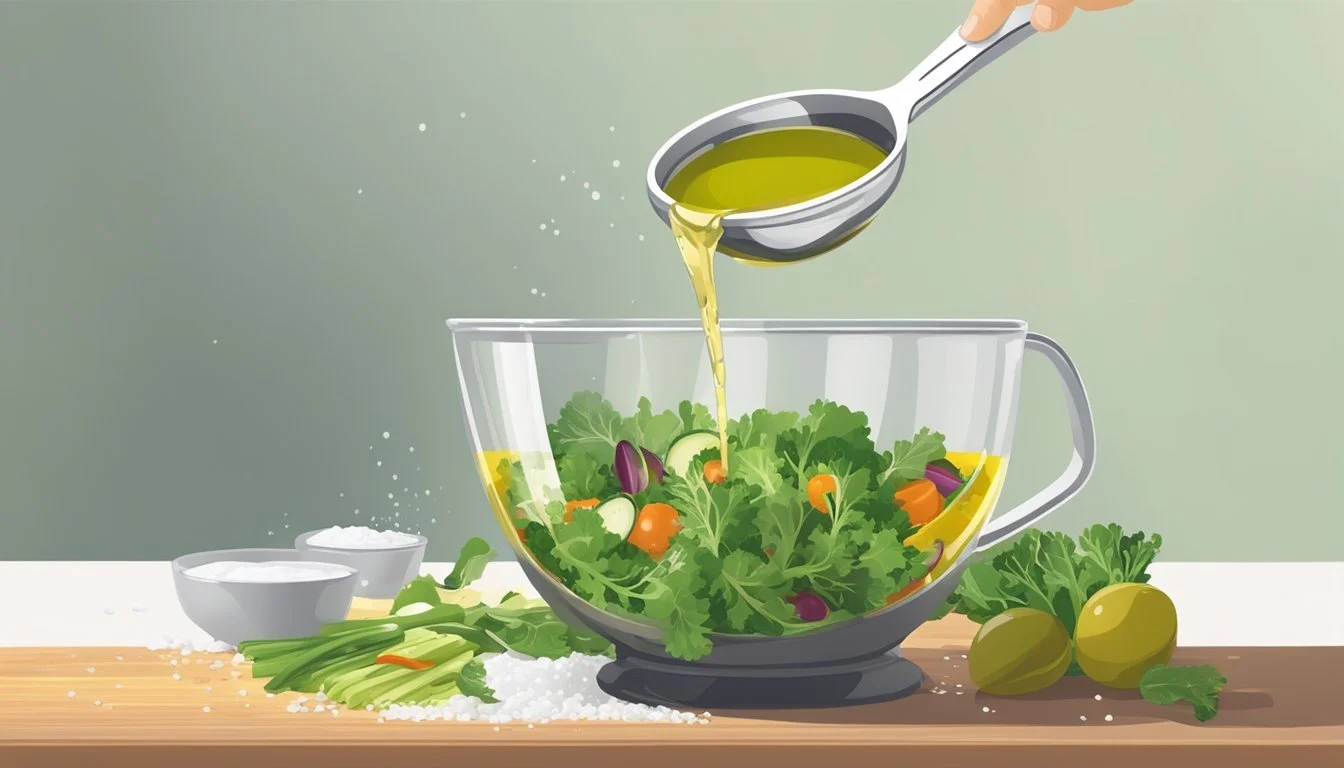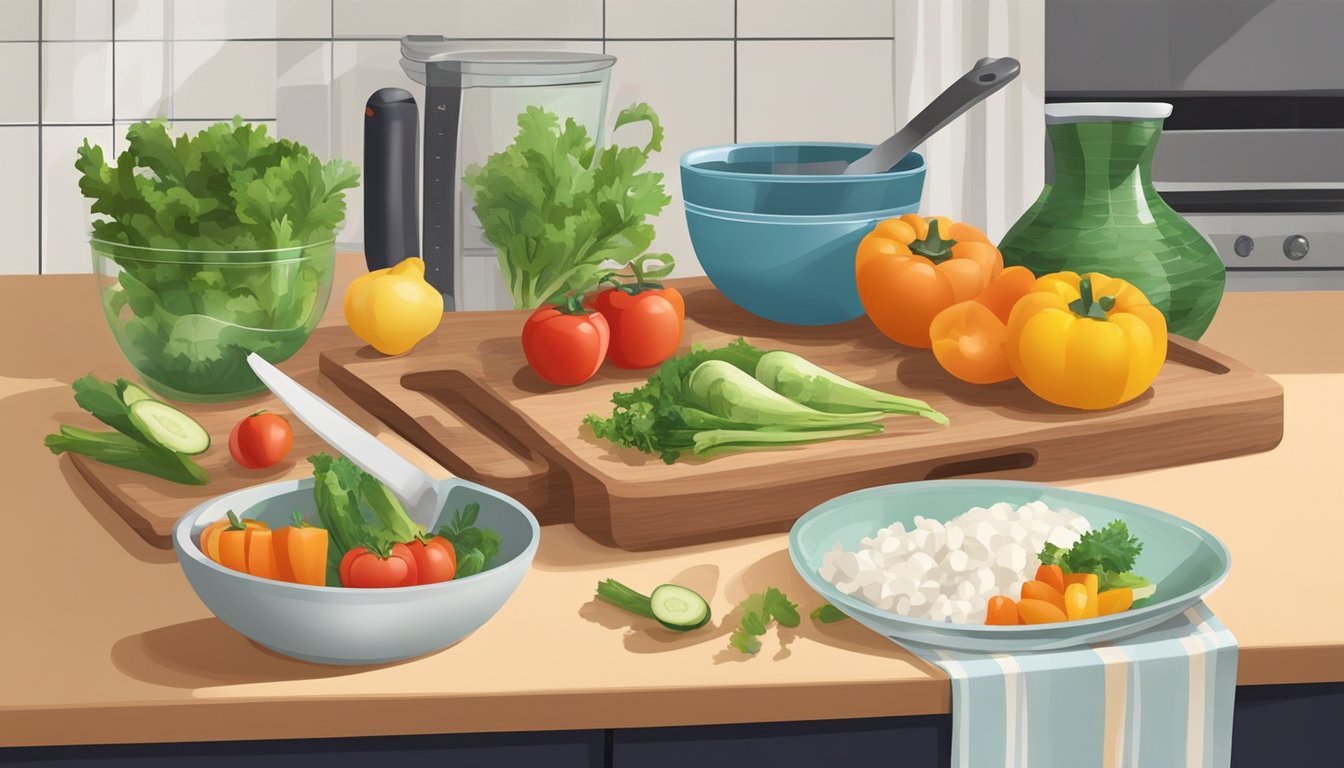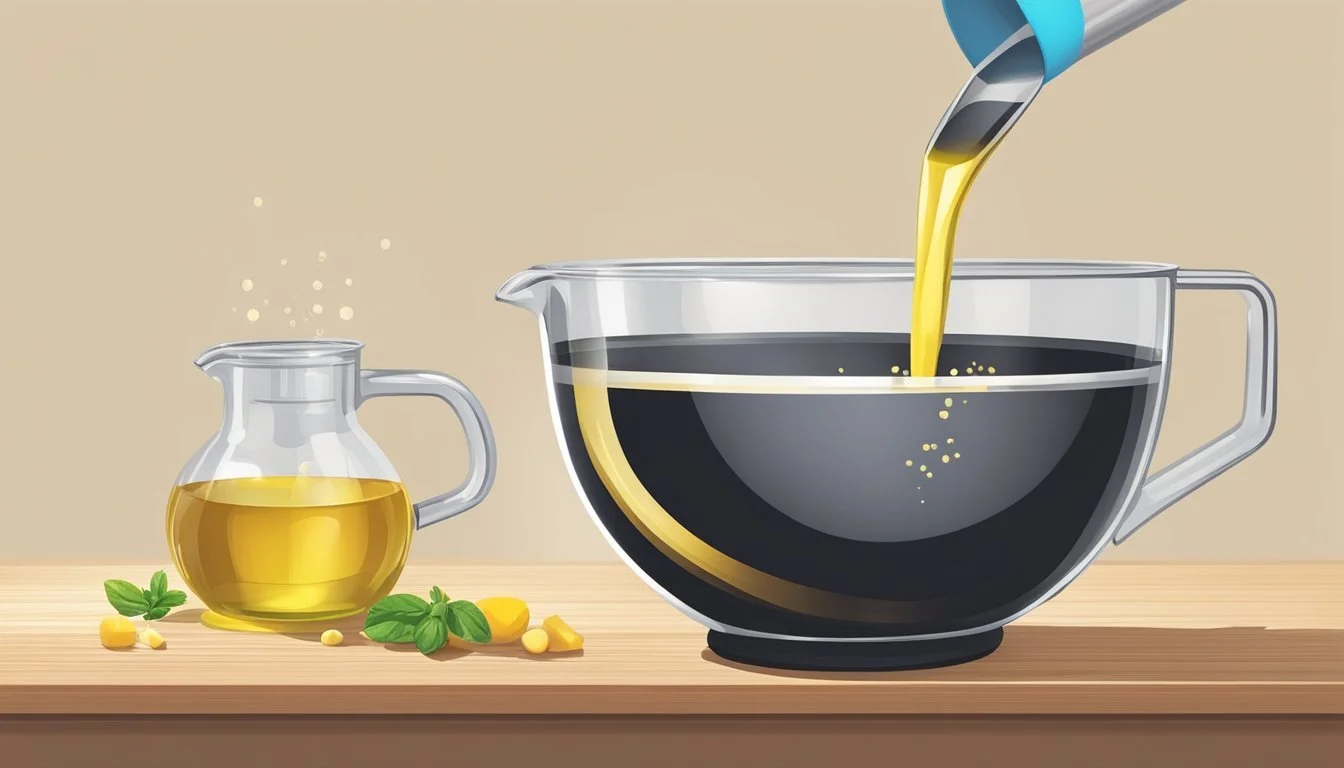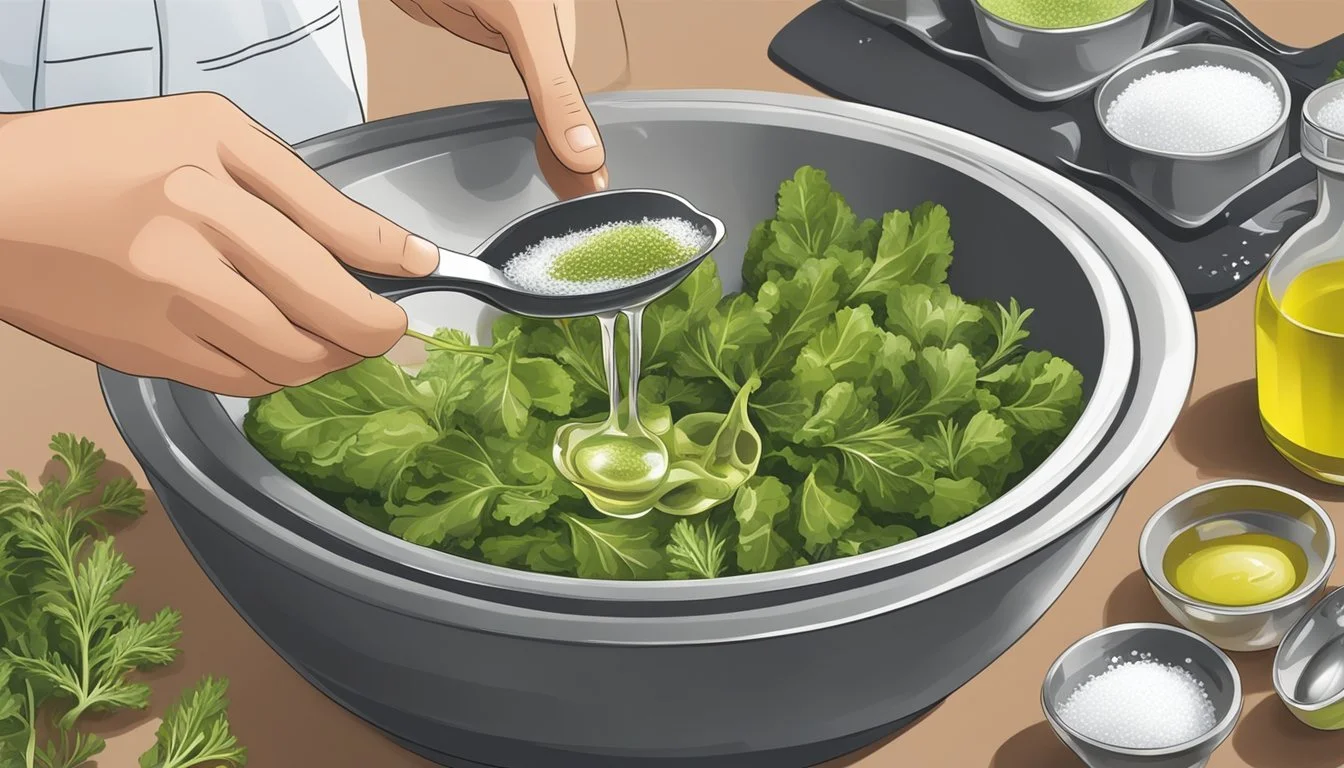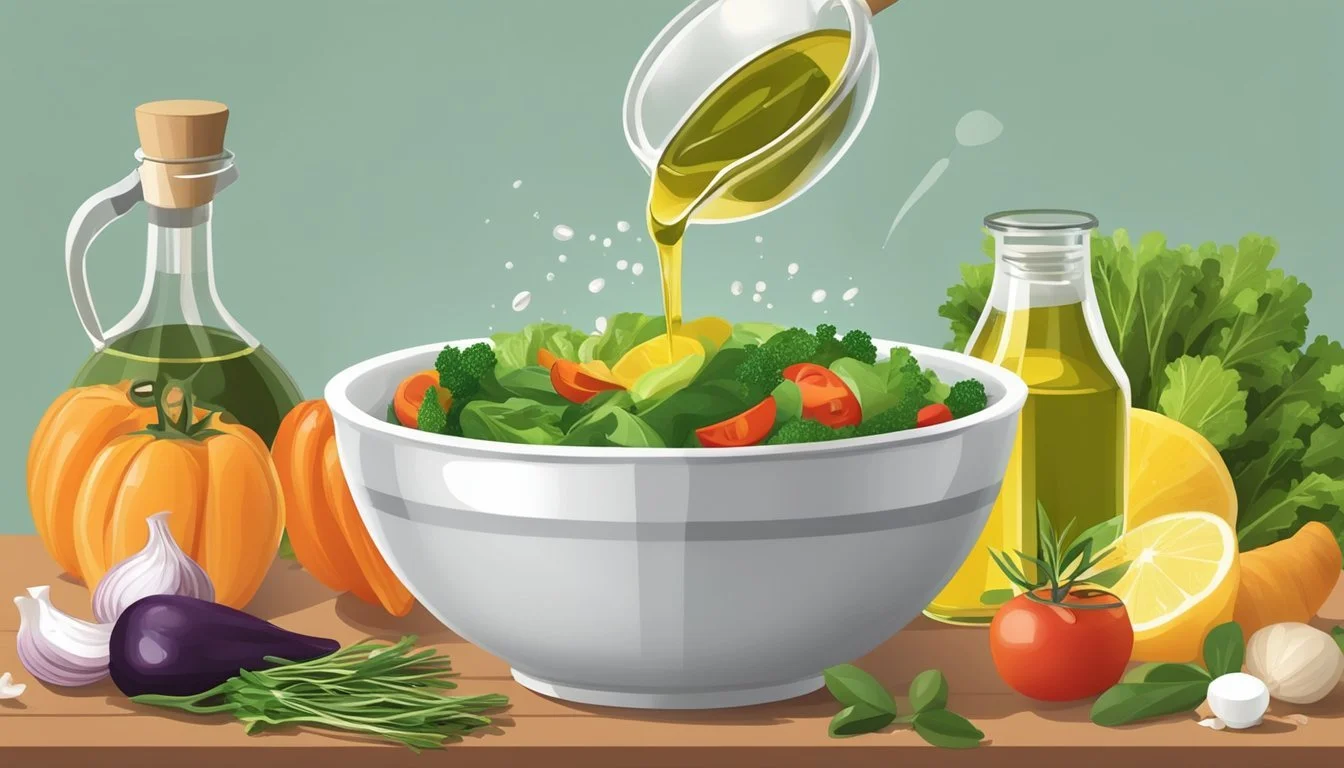How to Measure Ingredients for a Homemade Salad Recipe
Precision for Perfect Greens
Measuring ingredients accurately is essential for creating a homemade salad that is both delicious and nutritious. Precision in measurement ensures that the flavors are balanced and the nutritional value is consistent with the intended dietary goals. When preparing a homemade salad, it is key to consider the size and quantity of the ingredients, as this influences the final taste and presentation of the dish.
For a satisfactory outcome, they must select fresh produce and measure greens, vegetables, proteins, and dressings with attention to detail. Leafy greens, often the base of any salad, provide volume and need to be torn or chopped to a suitable size for ease of eating. Meanwhile, additional components such as tomatoes, cucumbers, and other toppings have to be measured to maintain a harmonious ratio between base and garnish, ensuring every bite is as flavorful as the last.
This meticulous approach to preparation not only enhances the quality of the salad but also aligns with nutritional guidelines. It allows for the precise tracking of caloric and nutritional intake, which is particularly important for those monitoring their diet. Ingredients like dressings and cheeses, when used with moderation, can keep the calorie count in check without compromising on taste. Therefore, proper measurement is the cornerstone of crafting a well-made homemade salad.
Understanding Salad Basics
When it comes to homemade salads (What wine goes well with salads?), whether as a side dish or main course, the key is in the preparation of the ingredients. A green salad often begins with a variety of leafy greens which provide a fresh and nutritious base. They might include:
Romaine: Crunchy with a mild taste.
Arugula: Peppery flavor, adds a zesty note.
Spinach: Tender and slightly sweet.
Kale: (What wine goes well with kale?) Sturdy with a more bitter taste.
Mixed Greens: Offer a balance of flavors and textures.
Preparing these greens involves a few simple but critical steps:
Wash: Always start by thoroughly rinsing the greens to remove any dirt or grit.
Dry: Greens must be dried to prevent diluting the salad dressing – a salad spinner or a clean kitchen towel can be used for this purpose.
Chop or tear: Depending on the texture desired, greens can be chopped with a sharp knife for cleaner edges or torn by hand for a more rustic appearance.
For a simple salad, one may consider adding additional components such as:
Sliced vegetables (e.g., cucumbers, tomatoes, onions)
A protein source (e.g., grilled chicken, tofu, or cheese)
A variety of toppings (e.g., nuts, seeds, dried fruits)
In regards to measurements, balance is key. For a single serving of a side salad, a good rule of thumb is about 1-2 cups of greens. For a salad as a main dish, 2-3 cups of greens serve as a hearty base. Quantity of toppings and dressing should be scaled accordingly to maintain the flavors without overpowering the base ingredients.
Selecting Fresh Ingredients
When creating a salad, the quality of the components can make a significant difference. It's important to choose ingredients that lend crispness, flavor, and nutritional value to your dish.
Choosing Vegetables
For leafy greens, one should look for lettuce that appears vibrant and firm, devoid of any wilting or brown spots. Greens like romaine and spinach not only provide a crisp foundation but are also rich in vitamins. When it comes to cucumbers, select those with dark green skin and a firm texture, indicating their freshness. A ripe tomato should be plump, with a bright and even color, and should give slightly to gentle pressure.
Opting for Proteins
Protein is vital for satiety and adding substance to a salad. When incorporating chicken, it should be cooked to the proper internal temperature and be juicy and tender. For those seeking a vegetarian option, chickpeas can be a great protein-rich addition. Cheese such as feta or parmesan can be included as a protein source as well as bringing a salty or tangy flavor profile to the salad. For vegan choices, one might consider tofu or tempeh as a protein substitute.
Adding Extra Flavors
A salad's appeal is often in its variety of flavors and textures. Fresh herbs, such as mint, contribute both taste and a vibrant pop of color. When selecting cheese to enhance flavor, opt for options like feta, which brings a briny tang, or parmesan, known for its nutty bite. Nuts and seeds are also excellent for adding crunch and nutritive value.
Preparing Homemade Dressing
Crafting a homemade dressing is a simple way to elevate any salad, allowing for customization of flavor while using fresh, quality ingredients.
Oil-Based Dressings
Oil-based dressings, commonly referred to as vinaigrettes, are a blend of oil and acid typically in a 3:1 ratio. For a classic vinaigrette, combine three parts olive oil to one part vinegar — like balsamic or apple cider vinegar. Infuse flavor by adding ingredients such as Dijon mustard, honey, and black pepper. Emulsifying the mixture is key to a cohesive dressing; do this by whisking vigorously or shaking in a sealed jar.
Creamy Dressings
Creamy dressings, such as Caesar, ranch, and blue cheese dressing, begin with a base of mayonnaise, sour cream, yogurt, or buttermilk. Balance these with an acid, like lemon juice or vinegar, then season with herbs and spices for depth. Homemade Italian dressing may include a mix of mayonnaise and red wine vinegar with Italian seasoning. Store creamy dressings in the refrigerator and aim to use them within one week.
Citrus and Vinegar Dressings
Bright and zesty, citrus and vinegar dressings rely on acids such as lemon juice or vinegars paired with oils like extra-virgin olive oil. A simple citrus dressing might feature freshly squeezed lemon juice, a sweetener like honey, a dash of salt, and black pepper. The tang of the citrus or vinegar balances the richness of the oil, creating a light and refreshing dressing suitable for a variety of salads.
Seasoning and Taste Enhancement
Proper seasoning is crucial for enhancing the natural flavors of a homemade salad. It involves careful measurement of ingredients to create a harmonious balance between saltiness, sweetness, and aromatic herbs and spices.
Balancing Salt and Sweetness
The foundation of most seasonings is a balance between salt and sweetness to bring out the natural flavors of the salad ingredients. A pinch of kosher salt can enhance the overall flavor profile, while an element of sweetness, such as a hint of honey or a dash of sugar, can round out the taste. They should be added gradually and tasted frequently to achieve the perfect equilibrium.
Salt: Start with 1/4 teaspoon of kosher salt for a salad serving 4 people.
Sweetness: Add sweetness in small quantities, taste, and adjust; for example, begin with 1/2 teaspoon of honey.
Adding Herbs and Spices
Herbs and spices introduce complexity and depth to a salad's flavor. For a fresh zesty punch, add chopped parsley or a squeeze of lemon juice. Dried herbs, such as dried oregano, can impart an earthy note. A judicious use of black pepper, preferably freshly ground black pepper, adds a subtle heat and aroma, enhancing savory elements without overpowering other flavors.
Parsley: 1 tablespoon, finely chopped
Lemon juice: 2 teaspoons, freshly squeezed
Dried oregano: 1/2 teaspoon, crushed slightly
Black pepper: 1/4 teaspoon, freshly ground
Finishing Touches
Final adjustments to the seasoning can transform a salad from good to exceptional. A final sprinkle of salt and pepper just before serving ensures a burst of flavor with each bite. The use of high-quality kosher salt and freshly ground black pepper is recommended for their purity and superior taste. Always season to taste, and consider the individual components of your salad – some may release their own salts or have inherent spicy characteristics.
Salt and pepper: Adjust according to taste, typically a light sprinkle is sufficient.
Assembling Your Salad
When assembling a salad, one should begin with a clean, dry base. For green salads, thoroughly dry the greens, as excess water can dilute the dressing. Tear or chop the leaves into bite-sized pieces for easy eating.
In a pasta salad, ensure the pasta is cooked al dente and cooled down before adding it to the mix. This provides the desired texture and prevents the salad from becoming soggy.
Textures play a crucial role in salad making. Adding ingredients like chopped nuts, seeds, or crispy croutons enhances the overall eating experience with a satisfying crunch. Alongside texture, color is also important. A variety of colorful vegetables such as bell peppers, cherry tomatoes, or shredded carrots can be incorporated to make the salad visually appealing. Fresh herbs like basil or parsley can add a pop of green and a burst of flavor.
For those who prefer tossed salads, it's critical to add the dressing just before serving to maintain freshness and prevent wilting. Drizzle the dressing evenly and toss the salad gently to coat all ingredients without breaking them down. A proper toss ensures each bite is flavorful.
To summarize, one should focus on the following when assembling a salad:
Start with a dry base.
Mix in a variety of colors and textures.
Add the dressing right before serving for tossed salads.
Adhere to these steps to create a delightful salad with balanced flavors and appealing presentation.
Food Safety and Storage
Ensuring the safety and longevity of ingredients for a homemade salad is crucial. Proper storage techniques not only preserve the freshness of ingredients but also maintain food safety.
Refrigeration Best Practices
For the refrigeration of salad ingredients, certain methods are key. Prior to storage, leafy greens should be dried thoroughly to prevent the proliferation of bacteria and mold due to excess moisture. To extend the shelf life and quality of greens in the refrigerator:
Paper Towels: Line storage containers with paper towels to absorb extra moisture.
Airtight Containers: Store the greens in airtight containers to keep them crisp.
Temperature: It's critical to keep salad ingredients cool at a consistent temperature, usually below 40°F.
Tips for Effective Refrigeration:
Dryness: Ensure salad elements are completely dry before refrigeration to reduce wilting.
Air Removal: When using bags, expel excess air to retard spoilage.
Separation: Keeping ingredients separate can prevent cross-contamination.
Proper Refrigerator Use:
Do not overfill the refrigerator, as this impedes the circulation of cold air.
Use designated crisper drawers if available, as they maintain an ideal environment for fresh produce.
Serving and Presentation
When serving a homemade salad, whether as a main dish or a side, precision in dressing application and thoughtful garnishing can transform the dish from ordinary to extraordinary.
Dressing Application Techniques
The technique of applying dressing to a salad can affect both the flavor and the texture. Even coating is essential. One method is to pour the dressing around the sides of the bowl, rather than directly on the leaves, and then gently tossing to distribute. This ensures each component retains its integrity without becoming soggy. For individual servings, consider serving the dressing on the side, allowing diners to dress their own salad to their preference.
Garnishing for Aesthetics
Garnishes should be selected not just for their flavor, but also to enhance the visual appeal of the salad. Use ingredients with a variety of colors and textures to create a visually attractive presentation. Common garnishes include:
Herbs: Sprinkle chopped parsley, dill, or chives to add a fresh look and taste.
Nuts: Toasted pine nuts, almonds, or walnuts provide a crunchy contrast.
Edible Flowers: Consider pansies or nasturtiums for a vibrant splash of color.
Arrange these garnishes on top of the salad after tossing it with the dressing to ensure they remain prominent and don't get buried under the leaves. When it's ready to serve, the salad should look as delightful as it tastes.
Health Benefits and Dietary Considerations
When preparing homemade salads, one should mind the nutritional values of the ingredients used and be aware of common allergies and intolerances. Selecting a balance of vegetables, proteins, and dressings can cater to various dietary needs, including calorie count, fat content, vegan or gluten-free preferences.
Nutritional Values
Calories: The total caloric value of a salad can vary widely. Leafy greens typically have fewer calories, while additions such as cheese, nuts, and dressings raise the calorie count. A mindful measure of high-calorie ingredients ensures a healthier salad without compromising taste.
Fat: Fats can be kept in check by choosing dressings wisely. Vinaigrettes made with a 3-to-1 ratio of oil to vinegar provide a healthier fat profile compared to cream-based dressings.
Vegan Options: Many salad components are naturally vegan, including most vegetables, fruits, and legumes. To supplement protein in vegan diets, one can add tofu, beans, or seeds.
Gluten-Free Choices: Salads are often gluten-free by default; however, certain dressings and croutons can contain gluten. Creating homemade dressings and opting for gluten-free grain alternatives like quinoa can ensure the salad meets gluten-free standards.
Allergies and Intolerances
Individuals with food allergies or intolerances should carefully read labels of prepackaged ingredients to avoid hidden allergens. Homemade salads offer the flexibility to substitute or omit ingredients that could cause reactions.
Common allergens that might be present in a salad include:
Nuts and seeds
Dairy products
Shellfish or other proteins
Gluten-containing croutons or dressings
By selecting fresh ingredients and preparing dressings at home, individuals have greater control over what goes into their salads, decreasing the likelihood of an allergic reaction or intolerance issue.
Exploring Salad Variations
Exploring the myriad of salad variations available can transform a simple dish into an international culinary adventure with ingredient pairings that push the boundaries of traditional flavors.
International Salads
Italian Salad: A classic Italian salad typically features a base of mixed greens such as arugula or radicchio. It often includes ripe tomatoes, cucumbers, and olives, with a generous sprinkle of mozzarella cheese or shavings of Parmesan. A drizzle of high-quality olive oil and balsamic vinegar completes this Mediterranean delight.
Caesar Salad: An Italian-American creation, Caesar salad traditionally contains romaine lettuce and croutons dressed with a robust dressing of garlic, anchovies, (What wine goes well with anchovies?) egg yolk, lemon juice, and Parmesan cheese.
Quinoa Salad: Quinoa salad, often enjoyed as a hearty, healthier alternative to traditional salads, can feature a vibrant mix of quinoa with crunchy vegetables. One can find variations of quinoa salads across different cuisines, incorporating local herbs and dressings.
Innovative Pairings
Kale Salads: Met with enthusiasm in contemporary cuisine, kale serves as a nutrient-rich canvas for salads. It pairs exceptionally well with sweet elements like berries, which not only add a pop of color but also a burst of flavor contrasting the kale's earthy tones.
Arugula Salad: The peppery bite of arugula makes it an exciting base for salads. Arugula salad variations include combinations with shaved Parmesan and pine nuts or with watermelon and feta for a sweet and salty experience.
Pasta Salad: Pasta salad is a versatile dish that serves well as a standalone meal or as a side. It can incorporate a variety of pasta shapes, from fusilli to penne, tossed with a colorful array of vegetables and heartier mix-ins like cheese cubes or grilled chicken, all bound together with a flavorful vinaigrette or creamy dressing.
Asparagus Salad: Fresh asparagus adds a crunchy, slightly earthy component to salads. It can star in a simple spring-inspired dish with a lemony dressing or elevate a mixed vegetable pasta salad with its substantial texture.
Through these variations, salads become a testament to cultural diversity and culinary creativity, offering endless combinations that cater to every palate and dietary need.
Useful Equipment and Tools
For precision in homemade salad recipes, the right measuring tools are essential. They enable the creation of consistent, balanced flavors by ensuring accurate proportions of dressings and ingredients.
Measuring Essentials
Dry Ingredients: A set of measuring cups and spoons is indispensable for measuring dry ingredients such as nuts, seeds, and croutons. They typically come in standard sizes ranging from 1/4 teaspoon to 1 cup.
Liquids: A mason jar with measurement markings is a multifunctional choice for measuring and storing salad dressings. One can both mix and store dressings in a mason jar, reducing the need for additional tools.
Pastes and Thickeners: For ingredients that don't level off easily like mustards or honey, a rubber spatula ensures an accurate measure by scraping out the entire contents from measuring spoons or cups.
Dressings and Sauces: A blender can be used to measure and blend dressing ingredients directly in its jar, especially for emulsified dressings where precision is key to achieving the right consistency.
Salad Greens: A salad spinner can be useful to measure out portions of greens after washing to ensure that they are dry and dressing will adhere properly.
For accurate measurement of ingredients:
Tool Use for Measuring Measuring Cups & Spoons Dry ingredients, such as seeds or grains Mason Jar Liquids and dressings Blender Blend and measure dressings Rubber Spatula Accurately scoop pastes and thickeners
Tips for Perfecting Salads
When preparing a homemade salad, it's crucial to measure ingredients accurately to balance flavors and textures. They should incorporate a variety of fresh produce and complementary additions to their meals.
Salad Greens: Ensuring greens are dry to avoid a watered-down dressing and a soggy salad is recommended. Using a salad spinner or patting leaves dry can achieve the best base for a salad.
Homemade Salad Dressing: A basic vinaigrette usually follows a 3-to-1 ratio of oil to vinegar, with the addition of herbs and seasonings for enhanced flavor. Incremental tasting as they season allows for adjustments according to personal preference.
Adding Texture: Incorporating a mixture of textures such as crunchy nuts, creamy cheese, or crisp vegetables provides a satisfying mouthfeel. Cutting or tearing greens into bite-sized pieces ensures ease of eating.
Restaurant-Quality Flavors: For achieving restaurant-quality taste, focusing on the freshness of ingredients is paramount. Garden-fresh vegetables and high-quality oils in dressings can make a significant difference.
Protein: If the salad is the main dish, adding a protein source is essential. Choices include grilled chicken, steak, fish, tofu, or beans, aiming for at least 15 grams of protein per serving.
Tossing Salad: To evenly coat the salad, tossing gently in a large bowl is recommended rather than pouring dressing on top which can lead to an uneven distribution of flavors.
By adhering to these guidelines, one can elevate a simple mix of ingredients into a delectable salad that touches on a harmony of flavors and textures found in fine dining.
Pairing Salads with Other Dishes
Selecting the right main courses and side dishes to accompany a salad can elevate a meal from good to great. Consider the balance of flavors and textures when pairing to ensure each dish complements the other.
Complementary Main Courses
When selecting a main dish to pair with a salad, one should consider the weight and intensity of flavors. A rich, hearty salad with bold ingredients like blue cheese and walnuts pairs well with lighter main dishes such as grilled chicken or fish. Conversely, a light citrus salad can be a refreshing complement to a more robust main dish like steak or lamb.
Grilled Chicken or Fish: Suits leafy green salads with vinaigrettes
Steak or Lamb: Goes well with citrus-based salads or ones with a hint of sweetness
Pizza, an all-time favorite, can be matched with a Caesar salad or a simple arugula salad with a drizzle of balsamic glaze, bridging the gap between indulgent and refreshing.
Matching with Sides and Appetizers
A properly chosen side dish or appetizer can prepare the palate for the salad and the main course to come. A light vegetable soup can start the meal, leading into a more substantial, crunchy salad.
Vegetable Soup: Begin with a soup as an appetizer, followed by a crisp salad.
For a holistic dining experience, one might pair a pasta salad served as a side with a creamy soup, making sure the flavors are in harmony and do not overpower each other.
Side Dish Salad Pairing Notes Creamy Soup Pasta Salad Balances richness with lightness Bread Baskets Tomato and Mozzarella Salad Textural contrast
It's important to match the intensity of flavors and consider how the textures interact between the salad, main dish, and sides to create a cohesive dining experience.

